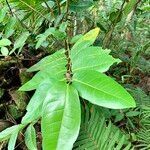Shrub or tree up to 15 m tall, terrestrial or hemi-epiphytic, sometimes lianescent. Branchlets drying brown to yellowish. Leafy twigs 1.5-4 mm thick, ± sparsely minutely hispidulous and/or white appressed-puberulous, ± scabrous or smooth; internodes solid. Leaves distichous; lamina oblong elliptic or obliquely (sub)rhombic, (2-)5-20(-30) by (1-)3-8(-13) cm, ± asymmetric, coriaceous, apex (sub)acuminate to subacute (to rounded), base ± inequilateral, cuneate to obtuse to truncate to subcordate or to subattenuate, one side sometimes slightly decurrent, margin entire or unilaterally (angular-) sublobate, often ± revolute; upper surface glabrous, smooth, often shiny, lower surface glabrous or sparsely hispidulous on the veins, smooth or scabridulous, often brown tessellate when dry; cystoliths on both sides; midrib slightly prominent to flat above; lateral veins 4-9(-11) pairs, the basal pair running close to the margin, up to 1/8-1/3 the length of the lamina, unbranched, most other lateral veins furcate far from the margin, tertiary venation reticulate to subscalariform; waxy glands in the axils of one of the basal lateral veins (or of both, but then unequal in size); petiole 0.3-1.5 cm long, sparsely minutely subhispidulous, the epidermis flaking off; stipules amplexicaul, 0.5-1 (-1.2) cm long, sparsely minutely puberulous, only ciliolate or glabrous, caducous. Figs axillary or just below the leaves, in pairs or solitary, sometimes ramiflorous; with a peduncle 0.1-0.6(-1) cm long or (sub)sessile; peduncular bracts 3, mostly verticillate at the base of the peduncle, 1-1.5 mm long; receptacle (sub)globose or ovoid to ellipsoid, 0.5-1 cm diam. when dry, 0.8-1.5 cm diam. when fresh, sparsely minutely hispidulous, scabridulous to almost smooth, without lateral bracts, yellow to orange or (dark) red at maturity, apex ± umbonate, ostiole c. 1 mm diam., surrounded by a rim; internal hairs minute, abundant. Tepals whitish, glabrous or ciliolate. Styles glabrous.
More
Trees, small trees, or shrubs, sometimes epiphytic. Bark slightly coarse. Branchlets brown. Stipules subulate-lanceolate, 5-10 mm, thick. Leaves distichous; petiole thick, 8-10 mm; leaf blade elliptic to ovate-elliptic, asymmetric, 3-13 × 2.5-6 cm, larger in juvenile plants, ± leathery to stiffly leathery, abaxially slightly rough, glabrous, base broadly cuneate to ± cordate, margin entire or toothed, apex obtuse to acute; venation abaxially conspicuous, not dark brown when dry; basal lateral veins short, secondary veins 5-8 on each side of midvein, and prominent on both surfaces. Figs axillary on normal leafy shoots, solitary or paired, globose to globose-pear-shaped, or ± pear-shaped, 8-10 mm in diam., with sparse small tubercles, slightly rough, base attenuate into stalk, apical pore navel-like; peduncle very short; involucral bracts ovate, margin revolute when dry. Male flowers: near apical pore; calyx lobes 4-6, white, linear; stamen 1; rudimentary ovary present. Gall flowers: calyx lobes 4-6, similar to male flowers; ovary obliquely ovoid; style lateral. Female flowers: calyx lobes 4, thin, transparent, linear; style persistent, lateral, short; stigma enlarged. Achenes ellipsoid, keeled, with tubercles. Fl. and fr. winter to Jul.
A fig. It is a small tree or shrub 2-4 m high. It can climb and scramble over other plants and be up to 10 m high. The small branches are rough. The small branchlets are yellow or pale brown. The bark is grey or brown and cracked or flaky. The leafy structure at the base of the leaves is sword shaped and 5-10 mm long and thick. The leaves of the tree are yellowish with purple veins and short leaf stalks. The leaves are 4-13 cm long and 2-6 cm wide. The leaf stalk is 0.6-1 cm long. Male and female flowers occur on separate plants. The figs are in the leaf axils and up to 2 cm across and orange coloured. There are some varieties described based on the size of the plant and the size of the figs.
See Ficus tinctoria G.Forst. subsp. tinctoria.
Moist valleys, rocks, in southern China. Typical of beach thickets or coastal rocky places in Fiji, but sometimes it is found inland at elevations up to 500 metres in dense or open forest, frequently on steep slopes.
More
A tropical plant. Trees are common on limestone or coral rocks near the sea shore. It tends to be on coral soils. In the Pacific it grows from sea level to 750 m altitude.


